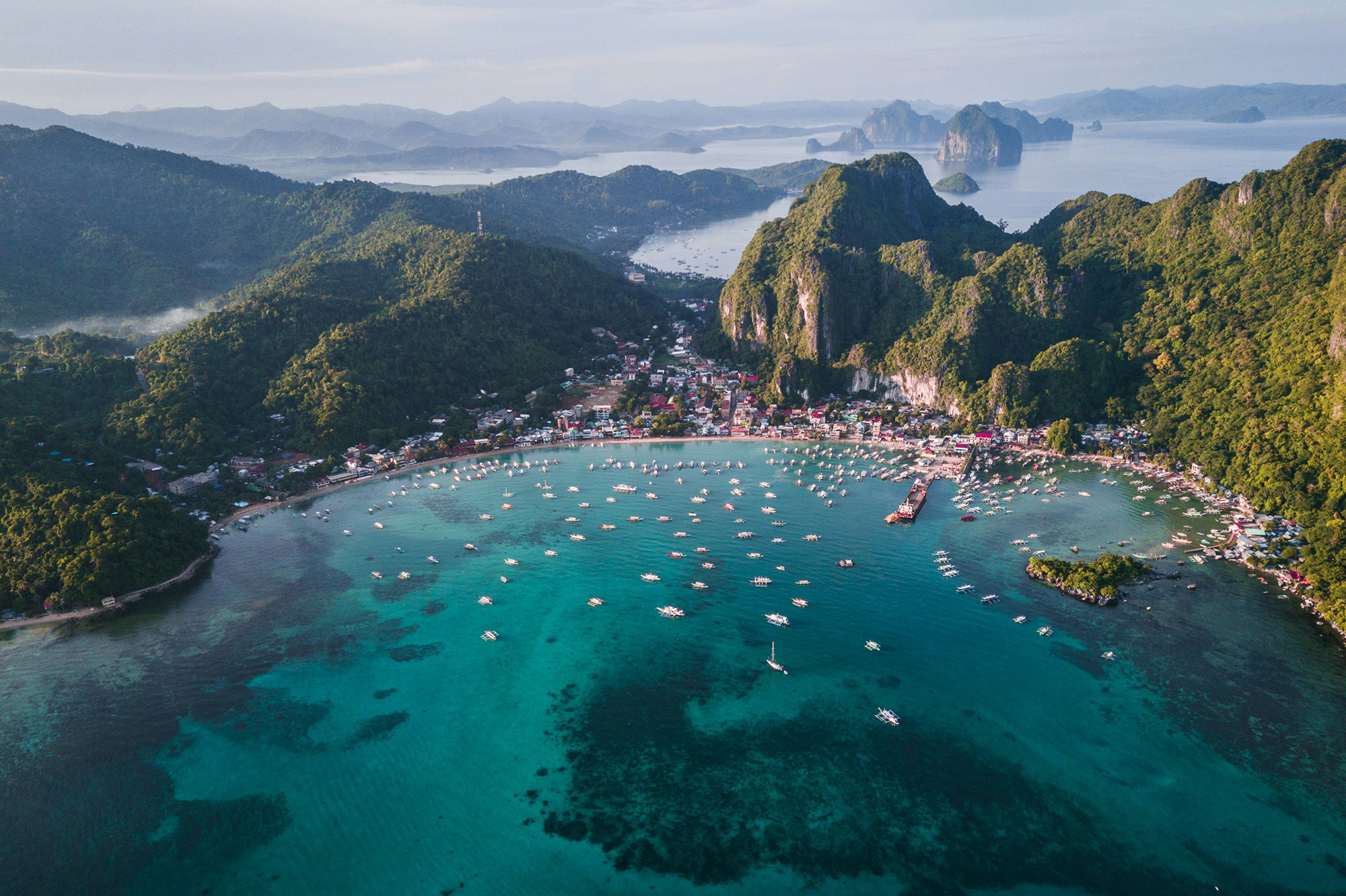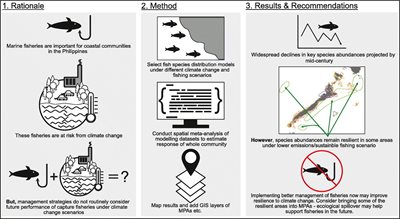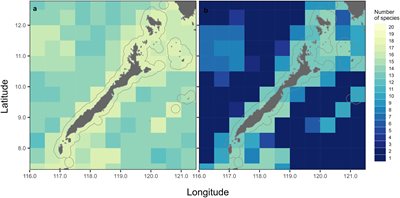Story
Incorporating climate-readiness into fisheries management strategies for tropical seas
5 March 2024
New collaborative study has developed an important addition to the decision support toolkit of tropical fisheries managers, to enable proper consideration of spatial management policies that will remain effective and sustainable in the face of diverse climate change impacts.

El Nido, Palawan, The Philippines by Eibner Saliba | Unsplash
Communities in the tropics rely on fish for at least 20% of their mean daily animal protein intake, and in some regions of the Indo-Pacific and West Africa, this figure is upwards of 50%. It is therefore vital that tropical fisheries are managed effectively, now and into the future.
However, fisheries in the tropics are increasingly vulnerable to a number of direct and indirect climate change impacts, including ocean warming, deoxygenation and acidification, which may affect the distribution and quantity of subsistence and commercially-important fish species in these regions.
The effects of climate change on the ocean environment will likely continue to increase until mid-century, even if greenhouse gas emissions are curbed now. These effects may impact natural population dynamics, habitat distribution and quantities of tropical marine fish even further.
To complicate matters further, the impacts of climate change across the marine environment are not consistent. Overall, climate change will have a negative impact but in some areas, it is projected that the impacts may be milder.
Therefore it is critical that climate-ready strategies, that can take advantage of the diversity of climate change impacts on these resources, are developed within fisheries management policies to help protect the vulnerable tropical fisheries and the food security they provide to many millions of people.
By analysing species distribution modelling projections for key species targeted by the Philippines’ fisheries, under two Representative Concentration Pathways for global emissions scenarios (RCP4.5 & RCP8.5) and varying degrees of fishing pressure, the team established that there will likely be widespread responses to climate change, affecting water-column species, such as scad and tuna, in particular.


Projected distributions of pelagic (a) and demersal (b) species in the reference decade (2011–2020) under RCP4.5/MSY0.
This study projected a decline in the quantities of fish across much of the case study area, highlighting the challenges of maintaining food security in the face of a rapidly changing climate. By the 2060s, similar reductions were also projected in seabed species, such as threadfin bream and some snappers, both of which are targeted by small-scale fishers in particular.
This is in keeping with previous studies of the effects of climate change on fisheries in the area, which suggested that catch potential in the Philippines could decrease on average by between 8% under the Intergovernmental Panel on Climate Change (IPCC) low future emissions scenario RCP2.6, and 24% under the very high future emissions scenario RCP8.5, by 2050.
These changes could have implications for the Philippines’ economy as a whole, with tuna exports worth approximately US$379 million in 2021, and it is possible that reductions in the smaller fisheries stocks that are traded within the Philippines could affect local nutrition.
Philippines’ fisheries are widely thought to be overfished and the study team suggest that addressing overexploitation in the near term could be key in promoting the future sustainability of the sector in the face of climate change. Exploitation management measures may help mitigate some of the effects of climate change, particularly under lower emissions scenarios, however, even with better management, it is likely that landings in the Philippines, as in other tropical areas, will still decrease so the research team also recommends that other approaches are explored.
Such approaches include:
- Monitoring of possible reactions of species to climate change impacts as a basis for their adaptive management.
- Further development of spatial management strategies, such as marine protected areas, that help preserve fish population resilience, age structure and genetic diversity in areas where fish populations are found to be less sensitive to climate change.
- Sustainable and considered expansion of aquaculture practices.
- The introduction of policies to promote catch diversification.
- The provision of alternative livelihood capacity building programs to diversify and secure incomes for coastal communities that rely heavily on fishing, to avoid the economic impacts of loss in resource in some areas.
“In this study, we apply techniques previously developed to assess the climate change sensitivity of target species to help inform the development of spatial management strategies for fisheries in areas which are especially vulnerable to marine climate change, such as the Philippines. The method we describe in this paper represents an important addition to the decision support toolkit for fisheries managers and practitioners in the Philippines and potentially, further afield.”
“Our work, specifically designed to support the spatial management of maritime sectors, provides a simple and easily interpretable means to answer important questions, such as which species are vulnerable or resilient to climate change and if there any new opportunities for the sector. This in turn allows managers to consider spatial management policies that will remain effective under future climate change scenarios, highlighting what can be done to support sustainability, rather than focusing only on what will be lost”.
Dr Benjamin Gonzales, co-author of this study and Vice President for Research and Development and Extension at the Western Philippines University, said:
“There are several challenges to overcome before the goal of climate-ready sustainable fisheries in the Philippines can be achieved. As is the case in many tropical reef fisheries, the stocks are overexploited, stock assessment data is limited or under-utilized, and fisheries managers have difficulty setting sustainable harvesting targets. Furthermore, stakeholder co-operation and governance/enforcement remain challenging due to limited capacity, resources and sustainable financing mechanisms at the local level.”
"Meanwhile, the result of this study is a critical input in planning and selecting climate-resilient locations of our Marine Protected Areas (MPAs), MPA networks, and Fisheries Management Areas in the Philippines".
Prof. Melanie Austen from the University of Plymouth and Programme Director for the GCRF Blue Communities research programme that funded this study, said:
“It is great to see yet another excellent example from Blue Communities of multi-national research partners working in collaboration to tackle complex environmental, economic and social challenges. Hopefully, by signalling both challenges of climate change and possible ways to address them, this research will be of benefit to the coastal communities that depend upon a healthy, productive and diverse marine environment”.
Related information
Full paper: Incorporating climate-readiness into fisheries management strategies